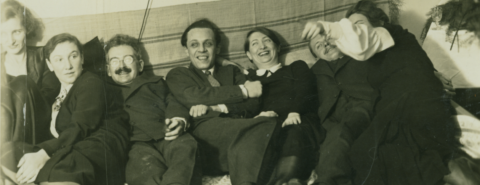Oxford University Press's Blog
November 26, 2025
Humour as a higher form of justice

Humour as a higher form of justice
Walter Benjamin, the intellectual hero of the 1968 generation and one of the most influential figures in German cultural and media studies, is still regarded as the quintessential melancholic. Yet his work is interwoven with reflections on humour and the political opportunities it offers.
Despite the evident interest in Benjamin today, his views on humour have received little attention so far. One reason for that may be that, unlike his explorations of melancholy, mourning, and allegory, his thoughts on this matter do not exactly leap out at the reader. In Benjamin’s oeuvre, humour plays a role similar to how he described the relationship between comedy and tragedy. He observed that while comedy is ‘the essential inner side of mourning,’ its presence is subtle—much like ‘the lining of a dress’, which may occasionally flash into view at the hem or lapel. In this manner, humour is neither a counterpart to the much-discussed interweaving of melancholy and the allegorical form of perception in Benjamin’s work, nor an isolated phenomenon. Rather, it is an integral part of a complex, often ambivalent structure of tension, consistently entangled with elements of melancholy, seriousness, and darkness.
The fashion metaphor of inner linings reveals a theoretical contraband that appears from time to time at significant points in Benjamin’s writings, spanning from his early linguistic-philosophical works to his media-aesthetic theses on cinema and his late materialistic concept of history. But rather than being the subject of a comprehensive study, his insights on humour are scattered across a wide range of texts. Most of these are small forms—critiques, fragments, satirical pieces—that engage with contemporary debates and bear witness to striking intellectual constellations. These include the engagement with authors such as Paul Scheerbart, Salomo Friedlaender, Karl Kraus, Jean Paul, Gottfried Keller, Johann Peter Hebel, Sigmund Freud, Charles Fourier, Georg Christoph Lichtenberg, and others. Moreover, laughter plays a crucial role in Benjamin’s writings on childlike modes of perception and expression, the reception of technology via popular culture, and his experimentation with hashish. Benjamin often expresses his ideas on humour only in passing, making it all the more surprising how much importance he attaches to this phenomenon. In this vein, The Author as Producer claims: ‘It may be noted, incidentally, that there is no better trigger for thinking than laughter. In particular, convulsion of the diaphragm usually provides better opportunities for thought than convulsion of the soul.’ If, however, laughter is the best way to stimulate thinking, where does it lead in Benjamin’s thought?
To begin with, Benjamin is not concerned with fundamental anthropological patterns of a universal human condition (unlike his contemporary Helmuth Plessner, for example). Instead, his focus is on concrete historical constellations, which possess specific expressive forms for capturing the experience of contemporary history. Whether looking at the literature of Gottfried Keller or Disney’s Mickey Mouse, the central question is always how humour, cheerfulness, laughter, and wit provide opportunities for dealing with one’s own time in a productive way—both aesthetically and politically; regardless of whether the time is marked by the massive upheavals of bourgeois society in the canton of Zurich around 1848, or by the overwhelming technological advancements of the period between the world wars. Productivity in this context means, first and foremost, critical thinking.
From very early on, Benjamin believed that humour serves as a mode of genuine criticism. In his letters, he compares it to rays of light that illuminate and dissect whatever they touch. At the same time, since laughter testifies to ‘shattered articulation’, humour has a tension-filled connection to language, pointing to a fundamental conflict between what is or can be expressed and what remains inexpressible. This disruption of human words is vital, as it also means the disruption of one of their fundamental operations: the distinction between good and evil, which is a basic condition of human judgment. In a fragment from around 1917 and 1918, now translated in our Forum Special Issue into English for the first time, Benjamin presents humour as an act that can bypass or even subvert judgment, thereby allowing for a different, higher form of justice beyond conventional moral norms. Benjamin greatly admired Johann Peter Hebel’s calendar stories, as he saw ‘applied justice’ in their humour. Rather than relying on judgment and punishment, he perceived this applied justice in Hebel’s stories as emerging from vivid narration, composition, and a scenic dramaturgy, animated by small rogues and swindlers and enriched by an abundance of details and props. What becomes apparent is a penchant for microscopic humour that avoids grand gestures and operates at the level of concretion.
These early thoughts stayed with Benjamin throughout his career, right up to his later work, where he emphasized the utopian qualities of laughter. Humour emerges in Benjamin’s work as a site of thought where his early writings intersect and resonate with his later materialist reflections. Notably, even in the Arcades Project, he draws inspiration from his initial ideas on humour. Of particular note here is the enormous relevance of early science fiction writer Paul Scheerbart. In his astral novels, Benjamin perceived not a description of reality at work, but the radical attempt to change it. In fact, Scheerbart’s visions of glass and lightweight architecture had a decisive role in shaping modern and even post-war architecture in Germany and elsewhere. Benjamin appreciated this offbeat author for two reasons. First, he valued Scheerbart’s understanding of technology as a medium of interacting with nature rather than dominating it. Second, he admired the humour in Scheerbart’s literature, which he felt could facilitate a profound metamorphosis of both human beings and society. It is precisely this metamorphosis that encapsulates the political potential of humor as higher justice. Ultimately, through the lens of laughter, there is still a great deal to discover in Benjamin’s aesthetic and political thought.
Feature image: Margot von Brentano, Valentina Kurella, Walter Benjamin, Gustav Glück, Bianca Minotti, Bernard von Brentano, Elisabeth Hauptmann (from left), Berlin (1931) © Akademie der Künste, Berlin, Elisabeth-Hauptmann-Archiv 758. Used with permission.
November 25, 2025
The truth about the microbiome: what’s real and what isn’t?

The truth about the microbiome: what’s real and what isn’t?
What’s really happening with those microbes inside us? Are we really superorganisms or is it all hype? Dr Berenice Langdon reveals the truth about the microbiome.
Does ‘microbiome’ mean our friendly gut bacteria?Yes, sort of. Many people are aware that the term ‘microbiome’ refers to ‘friendly gut bacteria’. But ‘microbiome’ also refers to all the microbes or germs inside us. These are mainly bacteria – but they also include fungi, viruses, and many others. The word ‘microbiome’ also refers to where these microbes are: the ‘biome’ part of the word. They couldbe in our gut, or on our skin but a microbiome can also refer to much bigger locations outside the body: the microbiome of a forest, even an ocean.
And going back to the human gut; are these microbes friendly? Well, some are and some aren’t. Like all best buddies, sometimes even the ‘friendly’ ones can be awkward sometimes.
Is it true that our microbiome helps protect us from infections?We know that if we take antibiotics, they can reduce our gut microbiome, and we can get a diarrhoea infection moving into our gut. On the other hand, we know that the microbiome is mainly made up of bacteria, and bacteria often cause infections. So does our microbiome protect us from infections, or does it cause infections?
The answer is a little bit of both. Our gut microbiome is usually made up of benign bacteria, the sort that don’t cause us harm. These benign bacteria keep the ‘baddy bacteria’, the pathogens, out of the gut. They do this either by outcompeting the bad bacteria, or by making the gut a bit too acidic for the bad bacteria to grow. In this way we can see that the gut microbiome is helping us, just a bit, to avoid gastrointestinal infections.
On the other hand, if our ‘friendly’ gut bacteria happen to get out of our guts and into the wrong place—like our blood stream or our brain—even though these bacteria are generally benign and friendly, they can cause a very serious infection.
Is it true that probiotics are live microorganisms that improve our health?We know that probiotics are live microorganisms. This is part of their definition, and the idea is that taking them is meant to improve our health in some way. It’s the ‘improve our health’ part that’s difficult to prove.
Scientists have been testing probiotics for decades to determine if they have an effect on our health. They’ve tested their effect on all sorts of medical conditions, including constipation, diarrhoea, ulcerative colitis, and irritable bowel syndrome, as well as other non-gut related conditions such as Parkinson’s and autism. So far, however, there’s no evidence to show that probiotics help any of these conditions. The American Gastroenterological Society mainly does not recommend taking probiotics except as part of a research trial.
Many probiotics currently on the market contain bacteria that are found in our food anyway (in yoghurt, for example), or in fact, are already inside us. Some probiotic packaging even says so itself: contains live microorganisms that naturally exist in the body.
If probiotics don’t do much, are they at least safe? The answer for most people is: yes, probably. The bacteria that make up probiotics are usually fairly benign and don’t usually try and attack us.
But for people who are very ill or in intensive care, probiotics are not recommended. Research shows that probiotics can translocate from the gut to the blood stream. Once in the wrong place—just like the microbes in our gut microbiome—probiotics can cause life threatening infections or even death.
Is it true that a microbiome is essential for survival?Amazingly, the microbiome is not essential for survival for all sorts of animals including rats, mice, guinea pigs, chickens, flies, and even fish. All of these creatures have been successfully raised without a microbiome. Even more amazingly, this isn’t new. Scientists have been doing this for over a hundred years. It’s absolutely possible for certain animals to survive just fine without a microbiome, and even have babies. This is a fascinating field of research, and these animals are sometimes known as gnotobiotic animals or germ-free animals.
However, it is true that herbivores can’t survive without a microbiome. They are dependent on gut microbes to help them ferment grass or foliage and extract the necessary calories. Herbivores really couldn’t survive without a microbiome.
Is it true that fermented foods and drinks are healthy?We know that not all fermented foods and drinks are healthy and interestingly, not all fermented foods and drinks have microbes in their final product. Alcohol is an obvious example of this; a fermented drink with known health risks and also one in which the final product contains no microbes whatsoever. Other popular fermented products such as soy sauce are full of salt and are also clearly not universally healthy, while the acid contained in the very popular fermented product cider vinegar can dissolve our teeth and is a known cause of oesophagitis.
However, we still love fermented foods. Fermentation often makes foods taste great and helps us preserve our food. So, while there are certain benefits to fermented food and drink in terms of food production and preservation, overall fermentation doesn’t automatically make foods healthy.
Is it true that we need to pay attention to our diets to improve our microbiomes?We should of course pay attention to our diet, by not eating too much, having a varied diet and including plenty of fibre, as this is the route to good health. But from a microbiome point of view, the bacteria in our guts don’t need much help.
Our colon typically contains a quadrillion bacteria per ml or 1,000,000,000,000 – a mind-blowingly large number. We also have a wide variety of bacteria inside us, constantly changing minute by minute. We obtain these effortlessly from the bacteria that coat the outside of our foods – even those foods we think of as ‘clean’ like bread and fruit as well as the bacteria naturally found within certain fermented foods mentioned above.
A wide variety of bacteria in our gut is regarded by some as a mark of health and is easily achieved by eating a wide variety of foods and by daily contact with each other, with the outside world, and with nature.
Is it true that together with our microbiomes we are superorganisms?No, this is not true. Together with our microbiomes we are not superorganisms. While microbes do help us a bit—helping us digest a little bit more food, avoiding certain infections—they also cause us a lot of work, as we have to protect ourselves from them and avoid infections. It is not a universally positive relationship.
But ultimately, we are not superorganisms simply because we do not evolve as one unit. Microbes evolve inside us at a vastly faster rate than we do. And we evolve slowly, evolving protective mechanisms against the microbes, but making use of them when we can.
Featured image by the National Institute of Allergy and Infectious Diseases via Unsplash.
November 20, 2025
Reintroducing Justice Robert Jackson

Reintroducing Justice Robert Jackson
In 1952, Justice Robert Jackson issued a concurring opinion in the case of Youngstown Sheet & Tube Co. v. Sawyer, in which a majority of the Supreme Court held that President Harry Truman could not invoke executive power to seize several of the major U.S. steel manufacturing companies in order to prevent a nation-wide steel strike that the Truman administration claimed would disrupt the participation of the United States in the Korean war.
Jackson’s opinion in Youngstown sketched a framework for executive power under the Constitution, identifying three examples of executive decisions against the backdrop of congressional authority. He set forth a continuum of executive power, ranging from instances in which executive decisions were “conclusive and preclusive” of the authority of other branches, to ones in which Congress and the executive shared powers and the branches operated in a “twilight zone” of concurrent authority, to ones in which an executive decision was in contradiction to a congressional effort to restrain it. When Jackson’s opinion appeared it garnered some appreciative commentary in academic circles but did not otherwise attract much attention.
Jackson’s Youngstown concurrence was revived, however, in two memorable opinions in American constitutional law and politics. The first was United States v. Nixon, in which Chief Justice Burger quoted a statement by Jackson that the dispersion of powers among the branches of government by the Constitution was designed to ensure a “workable government.” Burger concluded that allowing President Nixon to assert executive privilege against a subpoena in a criminal proceeding merely on the basis of a “general interest in confidentiality” would gravely interfere with the function of the courts and render the government “unworkable.” The second was Trump v. United States, in which Jackson’s statement in Youngstown that in some instances the president’s power to make executive decisions was “conclusive and preclusive” was used by Chief Justice Roberts to show that granting presidents absolute immunity for their official acts was necessary to enable them to execute their duties fearlessly and fairly.
More than seventy years after Jackson issued it, his Youngstown concurrence remains the most authoritative statement of the scope of executive power under the Constitution. But what of the justice who issued that opinion? Robert Jackson was arguably one of the most influential persons in the mid twentieth-century legal profession and a unique figure in American legal history. Yet today he is not widely known and has in some respects been misunderstood. Despite his having one of the largest collections of private papers in the Library of Congress, there has been comparatively little scholarship or popular writing devoted to Jackson. It is time to reintroduce him.
Jackson was the last Supreme Court justice to have entered the legal profession by “reading for the law,” a process where people apprenticed themselves to law offices prior to taking a bar examination. He would eventually study law for one year at Albany Law School and receive a degree, but he never attended college. His family were dairy farmers in western Pennsylvania and New York, and he was the first in his family to pursue a legal career. By 1934 he had become one of the more successful lawyers and wealthy residents in Jamestown, New York.
That year Jackson was approached by members of the Franklin Roosevelt administration and recruited to join the Bureau of Internal Revenue, even though his practice had not included tax law. From that position he progressed rapidly through New Deal agencies, becoming Solicitor General of the United States in 1938 and Attorney General in 1940. By that year he was on the short list for Supreme Court appointments, and was nominated to the Court by Roosevelt in 1941.
Jackson seemingly had every quality necessary to be an influential Supreme Court justice, possessing exceptional analytical and forensic skills and being a gifted writer. But he ended up somewhat unfulfilled on the Court, chafing about its isolation from foreign affairs during World War II and having fractious relationships with some of his fellow justices, notably Hugo Black and William O. Douglas. In the spring of 1945, he was offered the position of chief counsel at the forthcoming Nuremberg trials and took leave from the Court, uncertain about whether he would return. Jackson was largely responsible for the format of the trials, and although he had numerous difficulties with representatives of the other allied powers prosecuting Nazi war criminals, especially those from the Soviet Union, he said in his memoirs that he regarded his time at Nuremberg as the high point of his experience.
Jackson’s two years at Nuremberg were also a time in which he began an amorous relationship with his secretary, Elsie Douglas, to whom he would eventually leave his extensive private papers in his will. Douglas continued as his secretary when Jackson returned to the Court after Nuremberg, and when Jackson suddenly died of a heart attack in October 1954, it was in Elsie Douglas’ apartment. After Jackson’s return to the Court in 1946 his relations with colleagues improved, and his last major participation in a Court case came with Brown v. Board of Education in the 1952 and 1953 terms, in which Jackson, through writing successive memos to himself, eventually joined the Court’s unanimous opinion invalidating racial segregation in the public schools. Jackson had a heart attack in March 1954 and only returned to the Court on the day the Brown case was handed down. He then sought to recover over the summer of 1954, only to succumb that October.
All in all, a memorable life and career and a fascinating, complicated personality, whose remarkable talents somehow did not quite suit him for the role of a Supreme Court justice.
Featured image by Abdullah Guc via Unsplash.
October 26, 2025
“I’m good”

The word good does a lot of work in English. Aside from its garden-variety sense (as in “good game” or “good job” or “good dog”), we find the word has a number of extended uses. For example, it shows up in the funky expression “good and …” which means “very” when connected with short adjectives (“good and smart,” “good and hot,” “good and ugly”).
The expression “I’m good” is especially interesting. As a reply to “How’re you doing?” it can be a replacement for “I’m well,” “I’m fine,” or “I’m okay” (acceptable to all but the snarkiest of prescriptivists). “I’m good” also has a related sense in which it expresses satiation or satisfaction and implies refusal. When a server brings more coffee around or the bartender points to your empty glass, you might hold up a palm and say “I’m good.” Here “I’m good” is an indirect way of saying “No, thanks.”
In fact, “I’m good” is listed in the Oxford English Dictionary with the sense “no thank you; I’m not in need of anything.” The OED gives it as originally a US usage, with a first citation from 1966 in John Ball’s novel The Cool Cottontail. Asked if he wants another beer, detective Virgil Tibbs replies, “I’m still good, thanks.”
“I’m good” can also indicate a negative reply to a suggestion, as in this 2003 OED example from the Toronto Star:
‘Try these on Paige,’ says Emma, holding up the smallest pair of pink shorts I’ve ever seen in my life.
‘Thanks, I’m good!’ I tell her, laughing.
That was a definite “No” on the pink shorts. But sometimes “I’m good” seems to signal agreement. If you are planning to meet someone, you might propose a time by saying “Can we meet at 7:30?” and get a reply that “I’m good.” This may be a reduction of phrases like “I’m good with that.” Similarly, if you are inquiring of a friend or significant other whether they are prepared to do something. you might ask “Are you just about ready?” A possible reply (one of many), might be “I’m good.” Again this could be a reduction of “I’m good to go” or a response to an implied disjunction “Are you ready or do you have to go to the bathroom?” In the latter case, “I’m good” can indicate “No, I don’t need more time.”
Sometimes the meaning of “I’m good” is in the eye of the beholder. The linguist John Rickford recounts an incident involving two African American sisters who were on a bus that was being checked by Drug Enforcement Agency agents. When an agent asked if he could search their bags, one sister said yes. When he asked the other sister if he could search her, she said “I’m good,” which the agent took as “Okay.” He discovered some drugs and arrested the woman. She contested the search, and Rickford presented a long deposition giving evidence about the meaning and frequency of “I’m good” to mean “No, thanks.” The case ended in a plea deal with time served—two years. So the next time you say “I’m good,” stop to consider what you might be saying.
Featured image by Volkan Olmez on Unsplash.
October 23, 2025
Rethinking nuclear

As someone who has spent decades studying the evolution of nuclear energy, I’ve seen its emergence as a promising transformative technology, its stagnation as a consequence of dramatic accidents and its current re-emergence as a potential solution to the challenges of global warming.
While the issues of global warming and sustainable energy strategies are among the most consequential in today’s society, it is difficult to find objective sources that elucidate these topics. Discourse on this subject is often positioned at one or another polemical extreme. Further complicating the flow of objective information is the involvement of advocates of vested interests as seen in the lobbying efforts of the coal, gas and oil industries. My goal has been to present nuclear energy’s potential role in a sustainable energy future—alongside renewables like wind and solar—without ideological baggage.
An additional hurdle that must be overcome in dealing with the pros and cons of nuclear energy is the psychological context in which fear of nuclear weapons and of radiation impedes rational analysis. The deep antipathy to nuclear phenomena is illustrated by what might be called the “Godzilla Complex” that developed after the crew of the Japanese fishing boat, the Lucky Dragon 5, was exposed to heavy radiation from a nuclear weapons test in 1954. Godzilla was conceived as a monster that emerged from the depths of the ocean due to radiation exposure. It has become an enduring concept that has been portrayed in nearly forty films in the United States and Japan and in numerous video games, novels, comic books and television shows.
It is not surprising that fear of nuclear reactor radiation has been widespread. In spite of the fact that there are no documented deaths due to nuclear reactor waste (in contrast to deaths from accidents), it is widely assumed that nuclear reactor waste is quite dangerous. In contrast, the fact that premature deaths attributable to the fossil-fuel component of air pollution worldwide exceeds more than 5 million annually generates little concern. Similarly, the total waste produced from nuclear energy can be stored on one acre in a building 50 feet high, whereas for every tonne of coal that is mined, 880 pounds of waste material remain. Furthermore, this waste contains toxic components. Yet public concern for nuclear waste clearly overshadows that for coal, despite these contrasting impacts.
After an in-depth review of the most significant nuclear accidents and recognition of the deep psychological antipathy to nuclear energy, I’ve become increasingly interested in the emergence of an international effort to develop safe, cost-effective nuclear energy known as the Generation IV Nuclear Initiative. This began in 2000 with nine participating countries and has since grown substantially.
In the early years, the Generation IV Nuclear Initiative took a systematic approach to identify reactor designs that could meet demanding criteria—including the key characteristic of being “fail safe”. Rather than depending upon add-on safety apparatus, “fail safe” designs rely on the laws of nature—such as gravity and fluid flow—to provide cooling in the event that the reactor overheats. Another high priority design feature is modular construction, allowing multiple units to be constructed in a timely and economical fashion.
After reviewing dozens of options, the Generation IV Nuclear Initiative settled on six designs that it found to be the most attainable and desirable. Since its initial efforts, countries that have embraced the goals of the Generation IV Nuclear Initiative have been pursuing additional designs including reactors that range in size from quite small to about one third the size of the typical one megawatt reactor.
In my book, I’ve focused my attention on four promising designs. These four designs eschew the vulnerabilities of using water as a coolant that proved so devastating at Chernobyl and Fukushima. The explosion at Chernobyl was due to steam and the three explosions at Fukushima were due to hydrogen gas that resulted from oxidation of fuel rods by overheated water. These were not nuclear explosions. Instead, the four designs I’ve highlighted use liquid sodium, liquid lead, molten salts and helium gas as coolants. Liquid sodium and liquid lead cooled reactors are operating successfully in Russia, while China incorporated a gas cooled reactor into its grid in 2023. In the United States, Kairos Power is constructing a molten salt cooled reactor, while the TerraPower company (founded by Bill Gates) has broken ground on construction of a sodium cooled reactor in Kemmerer, Wyoming. These are intended to be models for replacing coal fired power plants with Generation IV nuclear plants. Multiple implementations of this approach are planned through the early 2030s.
Given the world-wide interest in Generation IV reactor development and the many initiatives that are being pursued, it is likely that at least some of these projects will come to fruition in the near future. While success is not guaranteed, there is clearly a need for the general public and students to be kept informed of progress leading up to 2030 and beyond.
To help bridge the knowledge gap in this rapidly evolving domain, I’ve launched a newsletter on Substack called “Nuclear Tomorrow.” It’s written for anyone concerned with the intersection of public policy, energy generation, and its impact on global warming. I hope it serves as a resource for those seeking clarity in a complex and consequential field.
Feature image: nuclear power plant via Pixabay.
October 22, 2025
What all parents need to know to support their teens in college

What all parents need to know to support their teens in college
With the semester well underway, your college student is probably juggling a lot—classes, homework, exams, and writing assignments—all while managing friendships, jobs, and other responsibilities. This balancing act can be tough for any young adult, but it’s often especially challenging for students with ADHD. In high school, your teen may have benefitted from built-in structure and support systems (e.g., teachers, parents) that helped them stay on track and meet their goals. In college, those supports tend to fade, leaving students to navigate much more on their own.
As a parent, you can play an important role in helping your student adjust to these new demands. Sometimes this means offering a little extra “scaffolding”—gentle support and guidance—to help them build the skills they need to thrive on their own. That’s exactly why I wrote Mastering the Transition to College: The Ultimate Guidebook for Parents of Teens with ADHD. It’s packed with practical information and strategies to help you and your teen navigate these years successfully. This blog post offers a first look at some of those tips, so you’ll have tools ready if your student starts to struggle, academically or otherwise, this semester.
Communication and collaboration are key. You probably know from the high school years that giving unsolicited advice to your teen can backfire. Pushing too hard often leads to resistance. Instead, try to use a calm, collaborative tone. Let your teen know you’re there to support and guide them, but that they are in control of their own decisions. Approaching conversations this way helps your teen feel respected and more open to brainstorming solutions with you.Set goals. Before you can help your teen make changes, it’s important to first understand what they want. Ask about their goals, not just in academics, but in all areas of their life that matter to them. Once you know their priorities, you can work together to map out what steps are needed to get there. This also makes it easier to guide them without feeling like you’re imposing. Some of these steps may be addressed in the tips below.Help your teen establish an organizational system. This may sound obvious, but it’s incredibly powerful: having a clear system to track tasks and deadlines is a game changer. Encourage your teen to choose a system that works for them. It could be a paper planner, a phone app, or a calendar on their laptop. The key is sustainability, so expect some trial and error as they experiment. Whatever they choose, the idea is that the system should be sustainable. The goal is to help them feel in control of their time, not overwhelmed by it.Encourage your teen to develop a system for completing tasks. College life means that the to-do list is rarely empty. Your teen may feel as if their tasks are never-ending… as one is completed, another is added to the list. Therefore, developing a method for triaging what needs to get completed and by when will be crucial. An approach that balances what is important vs. what is urgent is often a good place to start.Discuss all available campus resources with your teen. College campuses offer a lot of support to help your teen succeed. However, students (and parents) often find it difficult to know what resources are available and how to access them. Resources may be academic in nature (e.g., tutoring, office hours, advising, academic accommodations, writing center), mental health related (e.g., student health center, counseling center, skills groups), or logistical (e.g., career services, resident assistants). Knowing what resources to use, when, and how to access them will be essential for ensuring a successful college career. Further, if your teen needs more support than your conversations with them or my book can provide, finding a licensed professional may be a helpful next step. Outside help can be an important part of your teen achieving success.I hope these tips provide you with a solid starting point in supporting your teen with the transition to and through college. For even more guidance and detailed advice as to how to implement these strategies, check out my book Mastering the Transition to College: The Ultimate Guidebook for Parents of Teens with ADHD.
Feature image: photo by Joshua Hoehne via Unsplash.
October 17, 2025
Open Access Week: Nothing about me, without me

Open Access Week: Nothing about me, without me
In a 2011 speech about shared decision making in healthcare, the UK Secretary of State, Andrew Lansley, coined the phrase “nothing about me, without me”. Used at the time to summarise efforts to empower patients in decisions about their care, the phrase has since been borrowed by advocates and activists on a range of social justice topics.
This year’s Open Access Week poses the question: “How, in a time of disruption, can communities reassert control over the knowledge they produce?” Here at OUP, we were inspired to delve into our open access publishing for examples of research that doesn’t just study communities, but actively involves them. From shaping research questions to guiding implementation, these projects center the voices and experiences of the people at their heart. This commitment to community-led knowledge creation isn’t limited to the articles themselves. It’s reflected in the editorial policies, peer review practices, and team structures that support our journals—ensuring that open access is not just about availability, but about equity and inclusion in research and publishing processes:
Our Editors and authors publishing with Oxford Open Immunology use the Sex and Gender Equity in Research (SAGER) Guidelines to promote reporting of sex- and gender dimensions in research.The European Journal of Public Health is one example of a publication creating space for the promotion of the CARE Principles for Indigenous Data Governance, supporting the ability of Indigenous Peoples to control the use and application of Indigenous Knowledge and data for collective benefit.Many of our journals, Nucleic Acids Research included, utilise Early Career Boards to ensure their publications are managed in a way that serves the next generation of researchers and provides those earlier in their careers with experience contributing to journal development.Health Promotion International has created a special collection of research on participatory approaches in health promotion.Oxford Open Immunology has an open call for papers promoting the use of patient knowledge in research literature.JNCI: Journal of the National Cancer Institute and JNCI Cancer Spectrum are committed to supporting and advancing diversity, equity, and inclusion in editorial practices and published content. Recognizing that many populations have been systematically excluded from scholarly publishing, the journals have several initiatives strengthening diversity.From participatory research approaches to elder care, to self-determination paths for trans and gender diverse people, to rural ownership of businesses in areas of high tourism, and citizen empowerment during energy transitions – our open access publishing is full of examples of the benefits of including people in the process of generating knowledge about them. All articles included here are published with an open access license, ensuring peer-reviewed, trusted knowledge and diverse voices can reach everyone, anywhere in the world:
Diversity in Health InterventionsSelf-determination and self-affirmative paths of trans* and gender diverse people in Portugal: Diverse identities and healthcare by C Moleiro et al, European Journal of Public Health
Counting everyone: evidence for inclusive measures of disability in federal surveys by Jean P Hall et al, Health Affairs Scholar
Creating inclusive communities for LGBTQ residents and staff in faith-based assisted living communities by Carey Candrian, Innovation in Aging
Developing a co-designed, culturally responsive physical activity program for Pasifika communities in Western Sydney, Australia by Oscar Lederman et al, Health Promotion International
Co-creating a Mpox Elimination Campaign in the WHO European Region: The Central Role of Affected Communities by Leonardo Palumbo et al, Open Forum Infectious Diseases
Participatory development of a community mental wellbeing support package for people affected by skin neglected tropical diseases in the Kasai province, Democratic Republic of Congo by Motto Nganda et al, International Health
Inclusive Digital Health StrategiesThe ATIPAN project: a community-based digital health strategy toward UHC by Pia Regina Fatima C Zamora et al, Oxford Open Digital Health
From disease specific to universal health coverage in Lesotho: successes and challenges encountered in Lesotho’s digital health journey by Monaheng Maoeng et al, Oxford Open Digital Health
Implementing an inclusive digital health ecosystem for healthy aging: a case study on project SingaporeWALK by Edmund Wei Jian Lee PhD et al, JAMIA Open
Developing the BornFyne prenatal management system version 2.0: a mixed method community participatory approach to digital health for reproductive maternal health by Miriam Nkangu et al, Oxford Open Digital Health
Equitable Energy TransitionsEnergy communities—lessons learnt, challenges, and policy recommendations by L Neij et al, Oxford Open Energy
Solar-Powered Community Art Workshops for Energy Justice: New Directions for the Public Humanities by Anne Pasek et al, ISLE: Interdisciplinary Studies in Literature and Environment
Community participation and the viability of decentralized renewable energy systems: evidence from a hybrid mini-grid in rural South Africa by Mahali Elizabeth Lesala et al, Oxford Open Energy
Quantifying energy transition vulnerability helps more just and inclusive decarbonization by Yifan Shen et al, PNAS Nexus
Renewable energy and energy justice in the Middle East: international human rights, environmental and climate change law and policy perspectives by A F M Maniruzzaman et al, The Journal of World Energy Law & Business
Protecting Local CulturesEnriching Cultural Heritage Communities: New Tools and Technologies by Alan Dix et al, Interacting with Computers
A framework for tourism value chain ownership in rural communities by Michael Chambwe et al, Community Development Journal
Local government engagement practices and Indigenous interventions: Learning to listen to Indigenous voices by Christine Helen Elers et al, Human Communication Research
The strengths, gender, and place framework: a new tool for assessing community engagement by Justin See et al, Community Development Journal
Featured image by Mareike Mgwelo via Pexels.
October 16, 2025
How do you write a comparative politics textbook for changing times?

How do you write a comparative politics textbook for changing times?
When I studied comparative politics as an undergraduate in the 1990s, I was introduced to the field through static comparisons between national political systems. Each chapter in the textbook we read described a different country, and we learned about constitutions, legislatures, and parties as if they were fixed features of political life.
That approach has long since been overtaken by events. Today’s students live in a world where party systems are changing from election to election, new technologies are transforming political participation and communication, and authoritarian rulers are coming up with new ways of grabbing and holding on to power.
How should we teach comparative politics in this rapidly changing environment? That’s something I thought about when I sat down to write my new textbook, An Introduction to Comparative Politics. My answer has four parts.
1. Get to the key concepts and ideas right awayScholars of comparative politics ask two big questions: why are political systems so different from one another, and how do those differences matter for people’s lives? If we help students understand why those two questions are so important and guide them as they learn about the main differences between political systems, we can put them on a life-long journey of discovery. Today’s students have easy access to reasonably accurate data on political systems via their computers and their phones, so it’s not factual information they need from us—they need concepts and ideas they can use to make sense of the information that is available to them.
2. Take a global viewThe modern discipline of comparative politics developed in America and Europe in the nineteenth century, and it has long treated the institutions of North American and Western European democracies as the standard against which all other systems are measured. That attitude never made much sense, and it makes less sense today than ever, since many of today’s political challenges and conflicts have a global scope. Today’s students are eager to understand how the key concepts and ideas of comparative politics travel across continents—or, as is sometimes the case, they don’t.
3. Talk about historical changeThe turn away from static comparisons between national political systems also requires that we pay attention to processes of historical change, continuities, and resurgences.
It is remarkable how much history has been repeating itself lately. Over the last two decades, leading comparativists have presented in-depth analyses of “electoral authoritarianism”—conducting multi-party elections in de facto authoritarian regimes. As Theodore Zeldin showed in the 1950s, Napoleon III’s regime in France in the 1850s and 1860s had all the hallmarks of electoral authoritarianism. Other comparativists have examined the rise of populism. Donald Trump’s rise to power in the United States has a lot in common with Georges Boulanger’s meteoric political career in France in the 1880s.
4. Emphasize data and methodsFor better or worse, we live in a data-driven world, and whatever our students choose to do when they’re done studying, they’re going to need basic data literacy skills. This makes it all the more important for us as teachers to emphasize that comparative politics isn’t just a set of facts to memorize—it is a way of thinking about the world. Students need to become familiar with the main methodological approaches in comparative politics right away, including both broad cross-national comparisons and focused case studies. I therefore deemed it essential, when writing An Introduction to Comparative Politics, to present students with up-to-date data and up-to-date empirical examples in all chapters.
By learning the key concepts and ideas, taking a global view, tracing processes of historical continuity and change, and using diverse comparative methods, students can gain the independence of mind they need to make sense of politics throughout their lifetimes.
Feature image: photo by Bhabin Tamang via Pexels.
October 14, 2025
The sound of suspense: Hitchcock and Herrmann [playlist]

The sound of suspense: Hitchcock and Herrmann [playlist]
Listen to Bernard Herrmann’s eight scores for the films of Alfred Hitchcock. You’ll hear, in music, a mirror of how the duo’s personal relationship evolved, from its joyous start in late 1954 to its bitter end in 1966.
At the recording session for their first collaboration, The Trouble with Harry (1955), Hitchcock chuckled with delight. Herrmann had translated Harry’s darkly comic tone into music. His new friend “Benny” also captured in the score the director himself—his anxieties, his wit, his romantic fantasies. So much so that in 1968, when Herrmann crafted a concert suite from Harry, he titled it “A Portrait of Hitch.”
Their second pairing shows how quickly Herrmann joined Hitchcock’s inner circle. In 1956’s The Man Who Knew Too Much, Benny didn’t just write the score. He appears onscreen as himself, conducting the London Symphony in the film’s most famous set-piece: an attempted assassination in the Albert Hall. Herrmann’s main title “Prelude” is barely two minutes long; but it contains the seeds of all the main themes he’ll develop in the score. The “Prelude” also foreshadows the Albert Hall sequence with its concert-hall grandeur.
The Wrong Man (1956) may be their most surprising collaboration. To tell the true story of a jazz musician’s wrongful arrest, and the tragic impact it has on his family, Hitchcock used a more realistic visual style, and filmed in the story’s actual locations. For its “Prelude,” Herrmann delivers a surprise of his own: a lively samba tune that seems far removed from his usual style. But its sunny first measures are repeatedly answered—arrested?—by an ominous phrase for woodwinds that hints at the darkness to come.
Director and composer were at their best when depicting romantic obsession, and 1958’s Vertigo may be the summit of both artists’ careers. The psychological disorientation felt by James Stewart’s protagonist is conveyed by Herrmann’s famous “Prelude,” with its relentlessly repeating figures and orchestral swells. Hitchcock tailored the movie’s edit and its sound design to accommodate the music, most famously in Vertigo’s emotional climax. As Robert Burks’s camera glides 360 degrees around Scottie Ferguson (Stewart) and Judy Barton (Kim Novak), there is no dialogue—only Herrmann’s passionate “Scene d’amour.” As Hitchcock told his composer, “We’ll just have the camera and you.”
1959’s North by Northwest gave Herrmann his best opportunity to blend thrills with humor (he regretted that he was never asked to score comedies). Like Vertigo, the main titles of North by Northwest are a miniature movie in themselves, as designer Saul Bass’ perpendicular lines streak across Manhattan skyscrapers and bustling commuters.
Someone at MGM suggested that since the movie begins in New York City, the main title music should be “Gershwinesque.” What Herrmann did instead reflects his lifelong gift for thinking outside the box. His “Prelude” is based on the rhythm of a Spanish fandango—because, as the composer observed, the movie isn’t about New York: it’s about the “crazy dance that was going to happen now between Cary Grant and the world.”
When Grant’s man-on-the run meets a sexy blonde (Eva Marie Saint) on a train, the actors have just a few minutes to establish that this relationship is more than a casual one-night stand. Herrmann’s shimmering “Conversation Piece” is among his finest love themes, and convinces us in seconds that this couple is destined to share train berths for years to come.
If not for Herrmann, Psycho might survive today only in massively shortened form. After viewing a rough cut without music, Hitchcock decided that he had failed in his biggest gamble: a self-financed, low-budget shocker, targeted at young moviegoers hungry for edgy content. Hitch mused about cutting it down and putting it on his TV series. Herrmann watched the cut and saw what the director didn’t. He transformed the film with his all-strings score, “a black-and-white sound” to complement the black-and-white photography. His nerve-shredding “Prelude” was composed with one goal in mind—to tell moviegoers that, despite Psycho’s leisurely first scenes, “something terrible is going to happen.”
Hitchcock made only one request of his composer: no music for the murder scenes. Herrmann felt differently, leading to the ultimate validation of his film career. When Hitchcock heard the shrieking strings his composer unleashed for Marion and Arbogast’s killings, he admitted he had been wrong.
By the time Herrmann completed Marnie (1964), the onscreen tension was matched by a growing division between director and composer. Herrmann’s abrasiveness, and movie studios’ appetite for pop/rock soundtracks, were two of the factors that drove a wedge in what had been the closest of partnerships. Finally, on Torn Curtain (1966), Herrmann dared to write what he thought was best for the film—a brutal, dissonant score—even though it was the opposite of what Hitchcock had asked for. (Hitch wanted music that was “light” and with a “beat.”) Minutes after hearing Herrmann’s “Prelude,” their partnership and friendship came to an ugly end. The composer was fired, his score rejected.
Some of that music reached movie screens in 2019, when Quentin Tarantino featured two Torn Curtain cues in Once Upon a Time…in Hollywood. Nearly all of the scores represented here have surfaced in other media, re-used in Best Picture winners (The Artist), music videos (Lady Gaga’s Born This Way), TV (The Simpsons, Wednesday), plus commercials, pop songs and ringtones.
It’s easy to understand why. Herrmann remains unmatched in writing music that evokes timeless emotions—fear, love, hate, dread. And just as the gorgeous nightmares of Hitchcock’s cinema remain universal, the music of Bernard Herrmann is the fitting soundtrack of our own, anxious times.
Photo by Gary Meulemans on Unsplash.
October 10, 2025
Turn off AI. Pick up a crayon.

Turn off AI. Pick up a crayon.
Google Gemini offers “a new way to bring your imagination to life.” Adobe Firefly promises “The ultimate creative AI solution.” And Craiyon invites you to “Create AI Art.”
Don’t believe the tech hype. Close the generative AI window. And turn to the book that has sparked creativity for decades: Crockett Johnson’s Harold and the Purple Crayon. Published 70 years ago this fall, it is a manifesto for human creativity disguised as a children’s picture book—a message that’s even more relevant today than it was in 1955.
The opening pages of Harold and the Purple Crayon illustrate why throwing prompts into AI does not create art. Art begins by facing an empty canvas. Maybe you scribble a bit—as Harold does. Only after four pages of zig-zagging experiments does Harold pause and decide to take his line for a walk in the moonlight. Traveling along the line of your imagination requires your full attention. Resist the algorithm’s allure and become an active dreamer.
For Harold, as for most artists, drawing is a form of thinking. After drawing the moon for his walk in the moonlight, Harold makes “a long straight path so he wouldn’t get lost,” but he doesn’t “seem to be getting anywhere on the long straight path.” So, he leaves the path. But he had to create the straight path in order to realize that straight paths lead nowhere interesting. Making art is a process of discovery. Getting lost and making mistakes are part of the process.
A mistake might inspire a new direction or generate the art itself. Harold’s mistakes do both. Frightened by the dragon he has drawn to guard the apple tree, “His hand holding the purple crayon shook.” At this moment, the shaky crayon’s line oscillates between these different possibilities: a wavy scribble, or a series of conjoined cursive w’s, or the surface of an ocean in the visual language of the cartoon. So, as artists do, Harold grapples with uncertainty, and then has a realization: this line must be an ocean. When he recognizes that, the story can continue; Harold draws a boat and launches a several-page nautical voyage.
But AI’s risk-free, frictionless “creativity” launches nothing because friction generates the surprises that create art—the unpredictable results of an imagination in conversation with itself. For young people who may be dazzled by or even encouraged to use AI, let them also be encouraged to take the long road of doing things the “old fashioned” way because in doing these things ourselves, we learn, we grow, and we find our own voice.
It’s true that AI images can surprise us: that sixth finger or phantom arm in a photorealistic portrait of smiling people does make us look again. But art’s surprises emerge from a larger vision. Harold’s triangle-fingered, goggle-eyed policeman is Crockett Johnson gesturing towards the untutored abstractions of children’s art. It’s an intentional shift in the visual style. In contrast, AI’s extra fingers or limbs steer us into the uncanny valley—apt if the image illustrates horror fiction, but not if it’s supposed to represent, say, cheerful coworkers.
Drawing on decades of experience in the visual arts, Johnson’s aesthetic choices suit the story he is telling. Drawing from millions of works that feed its algorithm, AI can only imitate aesthetic choices. It cannot make them. And a statistically probable sentence or image can only gesture broadly towards the subtleties of human perception.
Because AI doesn’t understand why humans make art. Nor do the high-tech hucksters who are promising art without effort.
If you want to resist AI’s lure of frictionless creativity (and trust me, you do), open Harold and the Purple Crayon to experience the excitement of the creative mind at work. Johnson’s tale positions us as witnesses to the moment of artistic creation, watching Harold invent the story that we are reading while we are reading it. Although that’s not literally true, it feels true because the crayon—the embodiment of Harold’s apparent improvisation—is the engine of narrative. The story emerges from the path of a crayon which simultaneously generates and is inspired by the unfolding story.
The book’s ability to dramatize what creativity feels like is one reason it has inspired so many artists. Prince’s favorite childhood book, Harold is why Prince played purple guitars, favored purple fashion, and strongly identified with the color purple. Harold inspired Pulitzer-Prize-winning author Richard Powers to become a writer, and the name of Yale’s improvisational theatre group the Purple Crayon. Upon receiving the Caldecott Medal for Jumanji (1981), the classic picture book that would launch a film franchise, Chris Van Allsburg thanked “Jan Vermeer, for the way he used light; …Federico Fellini, for making films that look the way they do; …and Harold, for his purple crayon.”
Harold and the Purple Crayon has inspired so many because Harold’s journey is a story about what it means to be human—facing our challenges by thinking creatively, transforming problems into solutions, drawing new paths forward. When the scribble becomes an ocean, draw a boat. When it gets dark, draw a moon. To live is to improvise, and artists are our most gifted improvisers.
But developing our creative muscles requires the friction of crayon against paper, of imagination against impediment. If we delegate our dreaming to subcommittees of robots, humans’ unique strength—our capacity to imagine—will wither. If we outsource our creativity, we outsource our humanity.
And that is dangerous. Harold is in greatest peril when he slips from his unfinished mountaintop, stops drawing, and begins falling through space. These three pages mark the longest time that his crayon leaves the page. Put another way: he comes closest to his demise when, mid-adventure, he relinquishes the symbol of his creative mind. He stops thinking.
Then: “But luckily, he kept his wits and his purple crayon.” Harold presses crayon to page, draws a circle, which becomes a hot-air balloon that carries him to safety.
Johnson wrote the book while his own safety was at risk—under FBI surveillance and at risk of losing his livelihood due to McCarthyism. In daring to dream, he temporarily escaped surveillance and created a template for resilient, liberatory imaginations.
In these dangerous times, we might look to Harold’s crayon—or whatever that represents for each of us—and recognize the power of our imaginations. Rather than outsourcing our dreaming to machines, we can instead cultivate our capacity to imagine better futures.
And, come what may, remember what Harold would do: Always keep your wits and your purple crayon.
Photo by Dragos Gontariu on Unsplash.
Oxford University Press's Blog
- Oxford University Press's profile
- 237 followers



